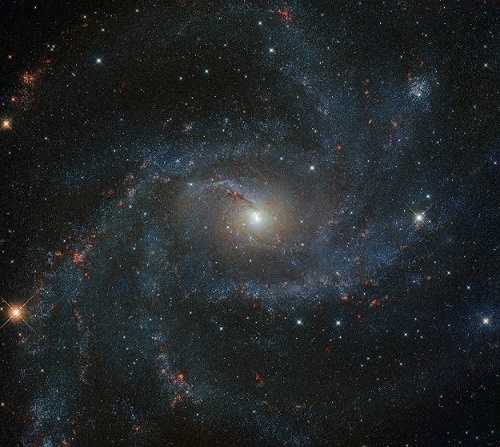नासा recently released the spectacular bright image of the firework आकाशगंगा NGC 6946 taken earlier by गुड़गुड़ाहट अंतरिक्ष दूरबीन (1)
A आकाशगंगा की एक प्रणाली है सितारों, remnants of stars, interstellar gas, dust, and dark matter that are bound together by gravitational force. According to an estimate, there are about 200 billion galaxies in the observable ब्रम्हांड (2). The solar system along with the sun is part of the आकाशगंगा called Milky Way which is our home आकाशगंगा.
NGC 6946 (एनजीसी का मतलब न्यू जनरल कैटलॉग है जो खगोलीय पिंडों को लेबल करने का एक सामान्य तरीका है) 7.72 एमपीसी {1 एमपीसी या मेगापार्सेक्स एक लाख पारसेक के बराबर दूरी पर स्थित आकाशगंगाओं में से एक है; खगोल विज्ञान में, दूरी की पसंदीदा इकाई पारसेक (पीसी) है। 1 पारसेक वह दूरी है जिस पर 1 खगोलीय इकाई चाप के 1 सेकंड का कोण अंतरित करती है अर्थात डिग्री का 1/3600; 1 पीसी 3.26 प्रकाश वर्ष के बराबर है} या 25.2 मिलियन प्रकाश-वर्ष नक्षत्र सेफियस में।
RSI आकाशगंगा, NGC 6946 में स्टार-गठन की असाधारण उच्च दर है, इसलिए इसे a . के रूप में वर्गीकृत किया गया है बर्स्ट आकाशगंगा. इस प्रकार की आकाशगंगाओं को 10 - 100 M . के क्रम में उच्च सितारा-गठन दर की विशेषता है☉/वर्ष जो सामान्य आकाशगंगाओं की तुलना में बहुत अधिक हैं, उदाहरण के लिए हमारी घरेलू आकाशगंगा मिल्की वे में, स्टार-गठन दर लगभग 1 - 5 M है☉/ वर्ष (3) (M☉ सौर द्रव्यमान है, खगोल विज्ञान में द्रव्यमान की मानक इकाई, 1 M☉ लगभग 2×10 . के बराबर है30 किलोग्राम।)।
On our time scale, सितारों appear to be unchanging but on the time scale of billions of years, सितारों undergo a life course, they are born, age and finally die. The life of a star begins in a nebula (cloud of dust, hydrogen, helium and other ionized gases) when the gravitational collapse of a giant cloud give rise to a protostar. This continues to grow further with accretion of gas and dust until it reaches its final mass. The final mass of the star determines its life time (lesser the mass, higher the life span) as well as what happens to the star during its life.
सब सितारों derive their energy from nuclear fusion. The nuclear fuel burning in the core creates strong outward pressure due to the high core temperature.This balances out the inward gravitational force. The balance is disturbed when the fuel in the core runs out. Temperature drops, outward pressure diminishes. As a result, the gravitational force of the inward squeeze becomes dominant forcing the core to contract and collapse. What a star finally ends up as after collapse depends on the mass of the star.
In the case of supermassive stars, When the core collapses in a short span of time, it creates enormous shock waves. The powerful and luminous explosion is called supernova. This transient astronomical event occurs during the last evolutionary stage of a supermassive star. The आकाशगंगा NGC 6946 is called the आतिशबाजी गैलेक्सी क्योंकि इसने केवल पिछली शताब्दी में ही 10 देखे गए सुपरनोवा का अनुभव किया है। इसकी तुलना में, आकाशगंगा का औसत प्रति शताब्दी केवल एक से दो सुपरनोवा है। इसलिए, NGC 6946 आकाशगंगा में अच्छी संख्या में सुपरनोवा अवशेष अपेक्षित हैं। NGC 6946 में पहचाने गए सुपरनोवा अवशेष उम्मीदवारों की कुल संख्या लगभग 225 . है (4,5). For stars more than 10 times the mass of the sun, the remnants would be काला छेद, the densest objects in the ब्रम्हांड.
The high star-formation rate (starburst), the high rate of supernova events (fireworks) features, spiral structure and it being positioned face-on with us sets this आकाशगंगा apart giving rise to its spectacular appearance in the images taken by the गुड़गुड़ाहट दूरबीन।
***
सूत्रों का कहना है
- नासा 2021। हबल एक चमकदार 'आतिशबाजी आकाशगंगा' देखता है। 08 जनवरी 2021 को पोस्ट किया गया। ऑनलाइन उपलब्ध है https://www.nasa.gov/image-feature/goddard/2021/hubble-views-a-dazzling-fireworks-galaxy/ 10 जनवरी 2021 को एक्सेस किया गया।
- नासा 2015। हबल से पता चलता है कि अवलोकन योग्य ब्रह्मांड में पहले की तुलना में 10 गुना अधिक आकाशगंगाएँ हैं। पर ऑनलाइन उपलब्ध है https://www.nasa.gov/feature/goddard/2016/hubble-reveals-observable-universe-contains-10-times-more-galaxies-than-previously-thought 10 जनवरी 2021 को एक्सेस किया गया।
- Muxlow TWB., 2020. स्टारबर्स्ट आकाशगंगाएँ। 8वीं यूरोपीय वीएलबीआई नेटवर्क संगोष्ठी, पोलैंड 26-29 सितंबर, 2020। पर उपलब्ध है https://arxiv.org/ftp/astro-ph/papers/0611/0611951.pdf 10 जनवरी 2021 को एक्सेस किया गया।
- लॉन्ग केएस, ब्लेयर डब्ल्यूपी, एट अल 2020। एनजीसी 6946 की सुपरनोवा अवशेष जनसंख्या जैसा कि एचएसटी* के साथ [Fe ii] 1.644 माइक्रोन में देखा गया है। द एस्ट्रोफिजिकल जर्नल, वॉल्यूम 899, नंबर 1। डीओआई: https://doi.org/10.3847/1538-4357/aba2e9
- रेडिका एमसी, वेल्च डीएल, और रूसो-नेप्टन एल।, 2020। SITELLE के साथ NGC 6946 में सुपरनोवा प्रकाश गूँज की खोज। रॉयल एस्ट्रोनॉमिकल सोसाइटी की मासिक नोटिस, खंड 497, अंक 3, सितंबर 2020, पृष्ठ 3297–3305, डीओआई: https://doi.org/10.1093/mnras/staa2006
***






































